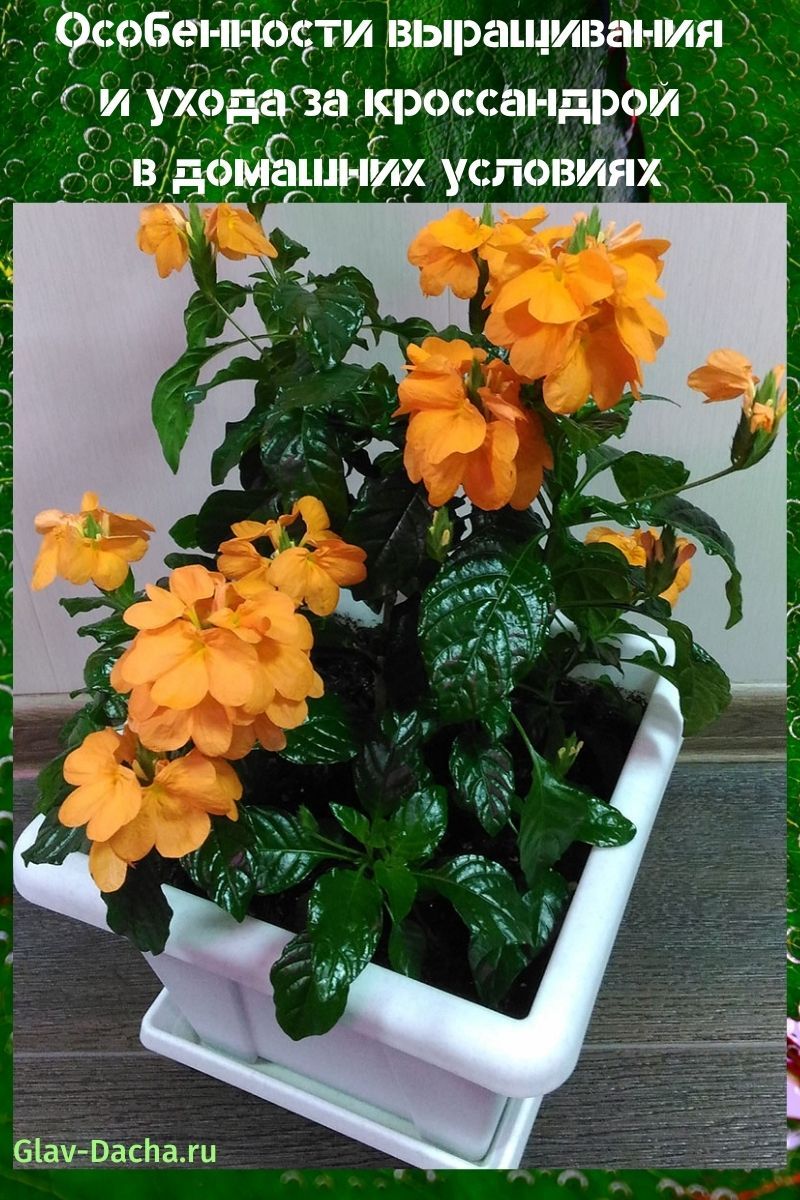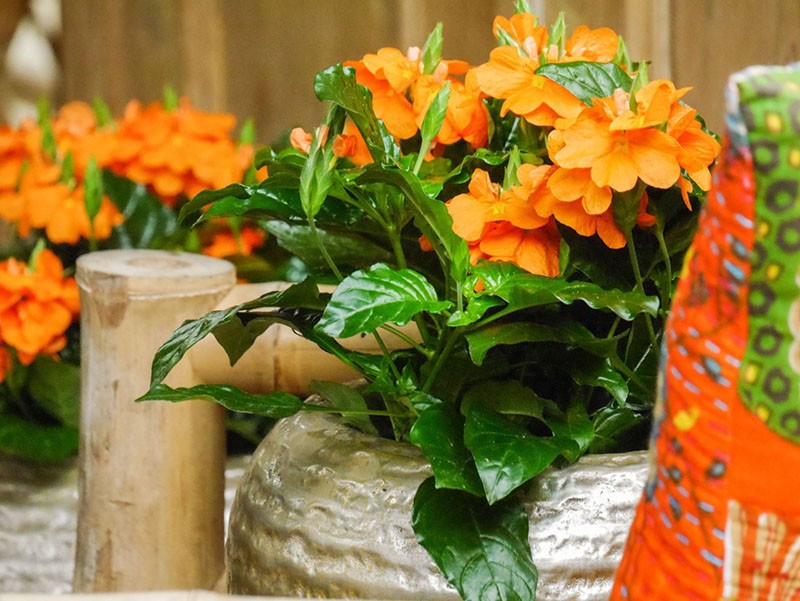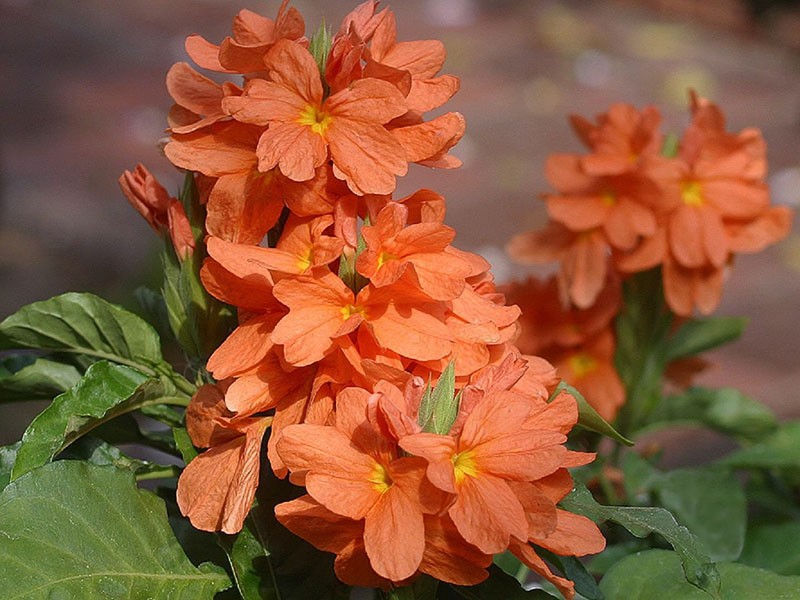Features of growing and caring for crossandra at home
 Caring for crossandra at home cannot be called simple, since the plant is very capricious and if some requirements are not met, it will be difficult to wait for abundant flowering. Nevertheless, the difficulties of growing and reproducing is not a reason to abandon a plant that can delight the eye with lush flowers for a long time. To make it easier for novice growers, consider the basic rules for growing and caring for a houseplant.
Caring for crossandra at home cannot be called simple, since the plant is very capricious and if some requirements are not met, it will be difficult to wait for abundant flowering. Nevertheless, the difficulties of growing and reproducing is not a reason to abandon a plant that can delight the eye with lush flowers for a long time. To make it easier for novice growers, consider the basic rules for growing and caring for a houseplant.
Caring for crossandra at home

Lighting and location requirements
 The best location for a flowerpot would be south-facing windows. It is this condition that will provide the plant with the right amount of light. In the summer, it is advisable to take the flower to the balcony, protecting it from drafts, wind or precipitation. If this is not possible, then the plant must be slightly shaded from direct sunlight in order to exclude burns on the leaves.
The best location for a flowerpot would be south-facing windows. It is this condition that will provide the plant with the right amount of light. In the summer, it is advisable to take the flower to the balcony, protecting it from drafts, wind or precipitation. If this is not possible, then the plant must be slightly shaded from direct sunlight in order to exclude burns on the leaves.
 In winter, the plant needs good lighting no less than in summer. Therefore, it is necessary to consider the option of artificial lighting in order to maximize the daylight hours. This condition is also observed if the windows in the apartment are located on the shady side of the house or have artificial shading by tall trees or adjacent buildings.
In winter, the plant needs good lighting no less than in summer. Therefore, it is necessary to consider the option of artificial lighting in order to maximize the daylight hours. This condition is also observed if the windows in the apartment are located on the shady side of the house or have artificial shading by tall trees or adjacent buildings.
One of the reasons why crossandra does not bloom is poor lighting, both in summer and winter.
Crossandra gets along well with other indoor plants, especially if they are ferns, begonias, fetonia and other types of tropical flowers, so there will be no difficulties in choosing a place on the windowsill.
Temperature regime
 The optimum temperature range for good growth and flowering is wide enough, from +18 to +28 degrees. Despite the fact that these are average indicators, and for some varieties they are not critical, you should not go beyond the recommended limits so as not to harm the plant.
The optimum temperature range for good growth and flowering is wide enough, from +18 to +28 degrees. Despite the fact that these are average indicators, and for some varieties they are not critical, you should not go beyond the recommended limits so as not to harm the plant.
Like any houseplant, the crossandra does not like sudden changes, so your task is to maintain optimal temperature conditions even in case of unforeseen situations.
 Pay special attention to airing the room so that the plant is not in a draft at this time and is not stressed due to changes in room temperature. The flower does not tolerate a dry climate very well, so the kitchen is not the room where the flower should be placed.
Pay special attention to airing the room so that the plant is not in a draft at this time and is not stressed due to changes in room temperature. The flower does not tolerate a dry climate very well, so the kitchen is not the room where the flower should be placed.
Indoor humidity
 Crossandra is a tropical plant accustomed to hot and humid climates. The abundance of light, warmth should be complemented by increased humidity, which can be provided in various ways.
Crossandra is a tropical plant accustomed to hot and humid climates. The abundance of light, warmth should be complemented by increased humidity, which can be provided in various ways.
You can achieve optimal humidity:
- Setting up an aquarium next to the crossandra.
- By regularly spraying the plant with a hand sprayer.
- Installation of a household air humidifier with an adjustable humidity level.
- Placing pallets with moss or expanded clay under the flower to collect water after watering.
If the method of spraying the plant is chosen as the maintenance of moisture, then make sure that the water falls only on the green part of the plant, on the leaves, and not on the inflorescences or buds.
In the winter season, the plant enters a dormant phase, the intensity of watering decreases, and top dressing is canceled. At the same time, it is necessary to reduce the humidity in the room, from the recommended 70% to 55%.
Watering rules
 If you want to have on the windowsill a lush plant with abundant flowers, care must be taken to water it evenly. Waterlogging of the soil, as well as its drying out, is detrimental to the plant. Especially if it happens in the summer.
If you want to have on the windowsill a lush plant with abundant flowers, care must be taken to water it evenly. Waterlogging of the soil, as well as its drying out, is detrimental to the plant. Especially if it happens in the summer.
If you missed this nuance, the crossandra has dried up or the plant has begun to fade - urgently engage in its resuscitation. To do this, take the flower to the bathroom and place it in a deep pan of water so that the plant can compensate for the lack of moisture. As soon as you notice that the leaves have begun to rise, move the plant to its usual place and try not to expose it to such stress anymore.
For irrigation, you need settled or filtered water, at room temperature. Watering frequency depends on the temperature in the room. As a rule, in winter, watering is required once every 14 days, while in summer, spring and autumn, the frequency of moisture increases.
Watering crossandra is necessary on demand. If you see that the topsoil has begun to dry out, this is a signal for action. More frequent approaches can lead to decay of the root system and the death of the plant itself.
Do you need feeding?
 The rules for caring for a crossandra at home also provide for feeding. To do this, acquire mineral or organic fertilizers and make them according to the scheme, 1 time in 10 days. During the flowering period, the frequency of feeding can be increased if you see a large number of discarded buds.
The rules for caring for a crossandra at home also provide for feeding. To do this, acquire mineral or organic fertilizers and make them according to the scheme, 1 time in 10 days. During the flowering period, the frequency of feeding can be increased if you see a large number of discarded buds.
Too long flowering period without feeding will lead to depletion of the plant itself and the soil, so your task is to support the flower and give it the strength to recover.
If you are interested in the question of the crossandra, how to care for a newly planted plant, and whether it needs feeding, we answer - fertilization is not needed in two cases when growing this flower:
- The winter period is when the plant is in an inactive growing season.
- A freshly planted plant that does not need additional stimulation for flowering for two months, as it needs time to develop the root system and recover after transplanting.
In other cases, feeding is an integral part of plant care.
Plant pruning
 The optimal time for pruning the crossandra is autumn, more precisely, the end of flowering. As soon as the last buds have faded, you can start cleaning.
The optimal time for pruning the crossandra is autumn, more precisely, the end of flowering. As soon as the last buds have faded, you can start cleaning.
The pruning process consists of several stages.:
- first, all thin, damaged or broken off branches that interfere with the development of the main crown of the plant are removed;
- then the longest branches of the flower are cut off, which have exceeded the permissible limits during the period of active growth;
- form a crown by pinching the upper parts of the branches.
The pinching procedure stimulates the growth of lateral shoots and thickening of the crown.
Plant transplant
 A donated or purchased plant needs a mandatory transplant, but on the condition that it does not bloom now. If this is a flowering plant that is in an active phase, it is necessary to wait until the last buds have bloomed and only then start replanting it.
A donated or purchased plant needs a mandatory transplant, but on the condition that it does not bloom now. If this is a flowering plant that is in an active phase, it is necessary to wait until the last buds have bloomed and only then start replanting it.
The transplant technique is quite simple:
- soak the soil in a pot, by abundant watering or immersion in a container of water;
- remove the root system of the flower and clean it of purchased soil;
- place the flower in a pre-prepared pot with a drainage filler, and fill it with new soil, leaving the outlet above the ground level;
- water the plant and fill up the prepared soil when it subsides.
If this is a planned plant transplant, then cleaning the root system is not required, it is enough to transfer from one pot to another, with the addition of fresh soil. Until the age of three, such a transplant is performed once a year, in the spring.
 The soil for planting a plant can be purchased at specialized stores, or made yourself.
The soil for planting a plant can be purchased at specialized stores, or made yourself.
To do this, you need to take such components:
- peat - 3 parts;
- compost - 3 parts;
- leaf land - 3 parts;
- river sand - 1 part.
Before combining all components, heat them by frying in a special container with the addition of water.
Reproduction methods
 After acquiring one plant, there is often a need for its reproduction. With proper care for the crossandra at home, such an opportunity will appear very soon, so you need to know in what ways this can be done.
After acquiring one plant, there is often a need for its reproduction. With proper care for the crossandra at home, such an opportunity will appear very soon, so you need to know in what ways this can be done.

Breeding methods:
- Seeds - to implement this method, it is necessary to prepare a mixture of peat, sand and sphagnum moss. The collected seeds are buried in the prepared soil by 5 mm and covered with plastic wrap on top. Place the container with seeds in a warm place with a high level of humidity and wait 2-3 weeks until the first shoots appear. After a month, the sprouts are ready to be transplanted into small pots.
- Cuttings are a more reliable method than the previous one, in addition, cuttings can be performed in three ways. The first is the rooting of cuttings in water, with the addition of activated carbon and "Kornevin". The second is rooting in peat tablets. The third is rooting in the ground under plastic wrap. On average, after 20-30 days, the first signs of growth can be seen.
Any of the above methods gives a result, only the percentage of effective reproduction in the second method is greater than that of the first.
Caring for crossandra at home with pests and diseases
 Like any plant, crossandra can get sick or be affected by pests. How to fix the situation if there is still very little experience in growing? On this score, there are several recommendations from experienced florists.
Like any plant, crossandra can get sick or be affected by pests. How to fix the situation if there is still very little experience in growing? On this score, there are several recommendations from experienced florists.
Reasons for the lack of flowering:
- unsuitable capacity;
- non-compliance with the conditions of detention (watering, humidity, lighting);
- lack of dressing;
- incorrect trimming.
The solution to the problem is compliance with the requirements for plant growing.
Why do the leaves of the crossandra turn red? The answer is too much lighting. The solution to the problem is artificial shading, which can partially reduce the intensity of sunlight.
Why do the leaves turn black and fall:
- the plant is in a draft;
- temperature regime is higher or lower than set.
The solution to the problem is compliance with the requirements for the care and growing of the plant.
Why do leaves turn yellow and wither? The answer is a fungal disease that affects the root system.
The solution to the problem is to transplant a plant with soil replacement and treatment of the root system with Fitosporin or Carbendazim.
Pests threatening crossandra:
- aphid;
- spider mite;
- whitefly.
The solution to the problem is the acquisition of funds whose action is aimed at destroying insects, without harming the plant itself.
Most of the problems associated with wilting leaves, dropping buds, etc. due to improper growing conditions. It is enough to adhere to the recommended boundaries and the plant will delight you with long and lush flowering.